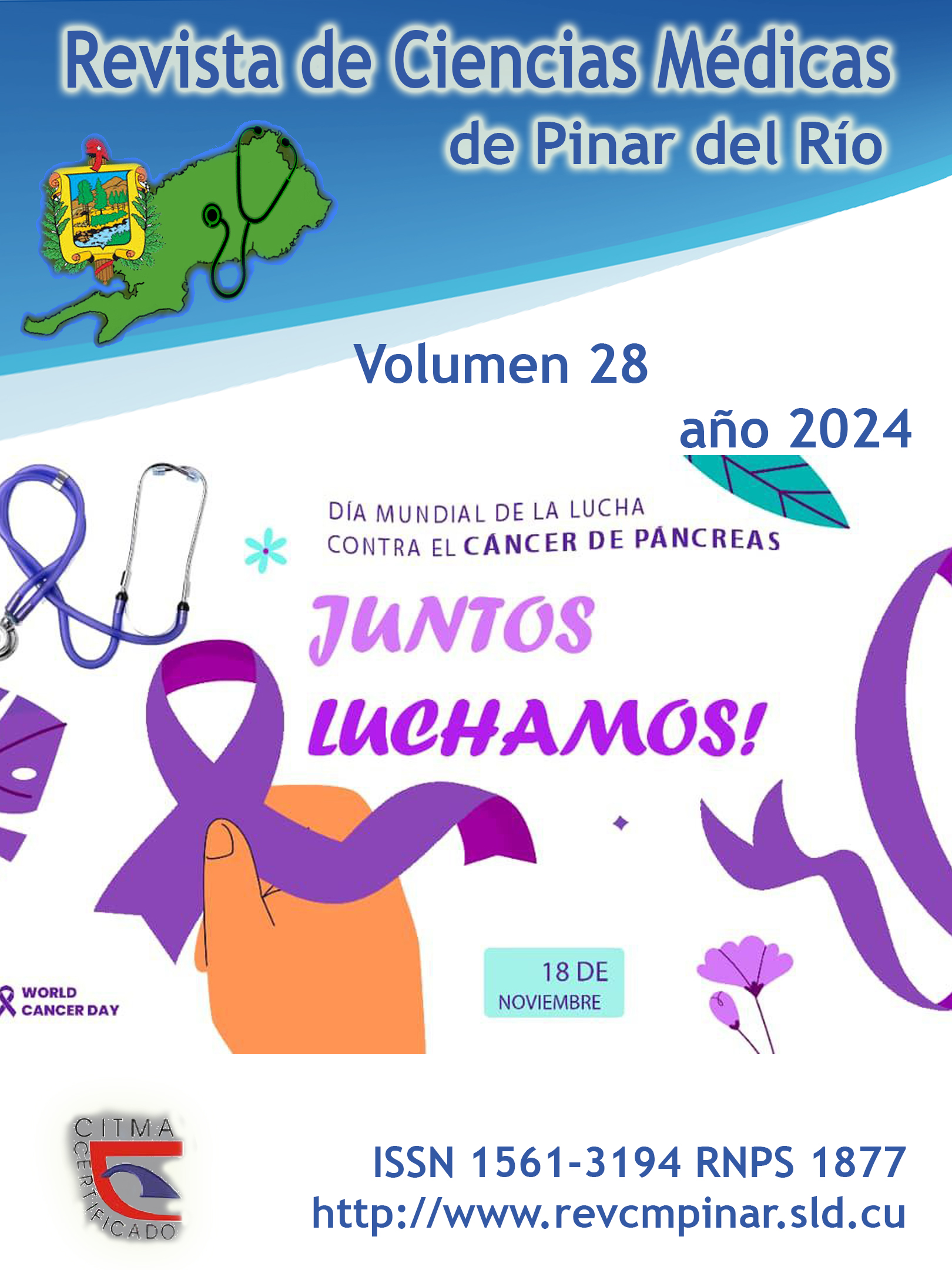Validation of Software for nutritional education in postgraduate studies
Keywords:
NUTRITIONAL EDUCATION, EDUCATIONAL SOFTWARE, TEACHING-LEARNING PROCESS.Abstract
Introduction: didactic innovation through the use of new technologies is based on originality, whether from the teacher, from the computer media, from the students as recipients or from the context of the formative implementation.
Objectives: to validate a software for nutritional education in postgraduate studies. "Food and nutrition in the different stages of life".
Methods: evaluation research was carried out in medical education, from January to April 2022. Theoretical and empirical methods were used: survey, observation; and statistical validation methods to determine if the software is applicable.
Results: it was found that educational software can be used in all forms of teaching organization. The internal evaluation of the software obtained 99 % of the final value of all the criteria analyzed and the external evaluation considered the use of educational software with the sample of teachers who used it; 95 % of the total score was obtained.
Conclusions: the educational software would be helpful in the different scenarios of the province of Holguín.
Downloads
References
1. Santos Velázquez T, Vega Rodríguez E, Peña Veja AE. Software educativo Elementos de Nutrident para el proceso enseñanza aprendizaje en Estomatología. Rev Ciencias Médicas [Internet]. 2018 [Citado 14/03/2023]; 22(6): 1113-1121. Disponible en: http://revcmpinar.sld.cu/index.php/publicaciones/article/view/3662
2. Lazo Herrera LA, Hernández Cabrera EP, Linares Cánovas LP, Díaz Pita G. SoftPuntura, software educativo sobre Acupuntura y Digitopuntura. Revista Cubana de Informática Médica [Internet]. 2018 [Citado 10/02/2023]: 10(1): 49-59. Disponible en: https://revinformatica.sld.cu/index.php/rcim/article/view/241/0
3. Troncoso Pantoja C, Amaya Placencia JP, Sotomayor Castro M, Chávez Mora E, Vidal Valenzuela J. Diseño de un simulador de ficha clínica electrónica para estudiantes de Nutrición y Dietética. Educ Med [Internet]. 2017 [Citado 14/03/2023]; 19(Supl3): 238-245. Disponible en: https://www.sciencedirect.com/science/article/pii/S1575181317301742
4. Méndez Véjar C, Parodi Fuentes CG, Bello Pimentel C, Villagrán Gutiérrez I. Percepción del aprendizaje en línea adaptado en contexto de COVID-19 en estudiantes de Nutrición. Inv Ed Med. [Internet]. 2021 [Citado 8/03/2023]: 10(4): 37-51. Disponible en: https://doi.org/10.22201/fm.20075057e.2021.40.21354
5. Baldwin SJ, Ching Y-H. Online Course Design: A Review of the Canvas Course Evaluation Checklist. Int Rev Res Open Dis [Internet]. 2019 [Citado 8/03/2023]; 20(3): 267-282. Disponible en: https://www.irrodl.org/index.php/irrodl/article/view/4283
6. Chen CH, Mullen AJ. COVID-19 Can Catalyze the Modernization of Medical Education. JMIR Med Educ [Internet]. 2020 [Citado 17/03/2023]; 6(1): e19725. Disponible en: https://doi.org/10.2196/19725
7. Ruiz Piedra AM, Gómez Martínez F, Gibert Lamadrid MP, Soca Guevara EB, Rodríguez Blanco L. Reseña histórica sobre la gestión nacional del desarrollo del software educativo en la Educación Médica Superior en Cuba. Revista Cubana de Informática Médica [Internet]. 2018 [Citado 15/02/2023]; 10(1): 28-39. Disponible en: http://scielo.sld.cu/scielo.php?script=sci_arttext&pid=S1684-18592018000100004
8. Saavedra-Muñoz LB, Riverón-Carralero WJ, Ochoa-Benítez NB, Hernández-Aguilar I, Santos-Remón D, Pupo-Micó AR. GastrOnSoft: software educativo sobre diagnóstico y tratamiento de neoplasias del tubo digestivo en Cirugía General. Rev Ciencias Médicas [Internet]. 2022 [Citado 17/03/2023]; 26(1): e5362. Disponible en: http://revcmpinar.sld.cu/index.php/publicaciones/article/view/5362
9. García Garcés H, Navarro Aguirre L, López Pérez M, Rodríguez Orizondo MF. Tecnologías de la Información y la Comunicación en salud y educación médica. Rev EDUMECENTRO [Internet]. 2014 [Citado 8/03/2023]; 6(1): 253-265. Disponible en: http://scielo.sld.cu/scielo.php?script=sci_arttext&pid=S2077-28742014000100018
10. Castañeda A. El papel de las Tecnologías de la Información y las Comunicaciones (TICs) en el proceso de enseñanza aprendizaje a comienzos del siglo XXI. En: Zilberstein J. Preparación Pedagógica Integral para Profesores Integrales. 2ed .La Habana: Félix Varela; 2013.p. 139-164.
11. Criollo Pedro LJ. Las bondades del software libre en el proceso de enseñanza –
aprendizaje en la educación media. Rev Interamericana de Investigación, Educación y Pedagogía [Internet]. 2019 [Citado 8/03/2023]; 12(2): 140-156. Disponible en: https://doi.org/10.15332/25005421.5011
12. Hernández Jaime J, Jiménez Galán YI, Rodríguez Flores E. Más allá de los procesos
de enseñanza-aprendizaje tradicionales: construcción de un recurso didáctico digital. RIDE [Internet]. 2020 [Citado 19/03/2023]; 10(20): e020. Disponible en:
13. Madariaga Fernández CJ, Ortiz Romero GM, Cruz Álvarez YB, Leyva Aguilera JJ. Validación del Software Educativo Metodología de la Investigación y Estadística para su generalización en la docencia médica. CCM [Internet]. 2016 [citado 20/03/2023]; 20(2). Disponible en: http://www.revcocmed.sld.cu/index.php/cocmed/article/view/2031
14. Gutiérrez Segura M. Software educativo como recurso para el aprendizaje en la carrera de Estomatología en Holguín. CCM [Internet]. 2020 Jun [citado 2023 Ago 07]; 24(2): 781-793. Disponible en: http://scielo.sld.cu/scielo.php?script=sci_arttext&pid=S1560-43812020000200781&lng=es.
15. Delgado Rodríguez Y, Delgado Rodríguez Y, Pérez Pérez SM, Rodríguez Polanco M, Escalona Perdomo R. Software educativo de matemática para estudiantes de Vigilancia y Lucha Antivectorial. Rev Ciencias Médicas [Internet]. 2021 [Citado 8/03/2023]; 25(5): e5074. Disponible en: https://revcmpinar.sld.cu/index.php/publicaciones/article/view/5074
16. Villavicencio Gallego S, Abrahantes Gallego Y, González Alcántara SM, Martínez Laguardia AS. Uso de las tecnologías de la información y las comunicaciones en la educación médica. EDUMECENTRO [Internet]. 2019 [Citado 8/03/2023]; 11(4): 266-273. Disponible en: http://scielo.sld.cu/scielo.php?script=sci_arttext&pid=S2077-28742019000400266
Downloads
Published
How to Cite
Issue
Section
License
Authors who have publications with this journal agree to the following terms: Authors will retain their copyrights and grant the journal the right of first publication of their work, which will be publication of their work, which will be simultaneously subject to the Creative Commons Attribution License (CC-BY-NC 4.0) that allows third parties to share the work as long as its author and first publication in this journal are indicated.
Authors may adopt other non-exclusive license agreements for distribution of the published version of the work (e.g.: deposit it in an institutional telematic archive or publish it in a volume). Likewise, and according to the recommendations of the Medical Sciences Editorial (ECIMED), authors must declare in each article their contribution according to the CRediT taxonomy (contributor roles). This taxonomy includes 14 roles, which can be used to represent the tasks typically performed by contributors in scientific academic production. It should be consulted in monograph) whenever initial publication in this journal is indicated. Authors are allowed and encouraged to disseminate their work through the Internet (e.g., in institutional telematic archives or on their web page) before and during the submission process, which may produce interesting exchanges and increase citations of the published work. (See The effect of open access). https://casrai.org/credit/



